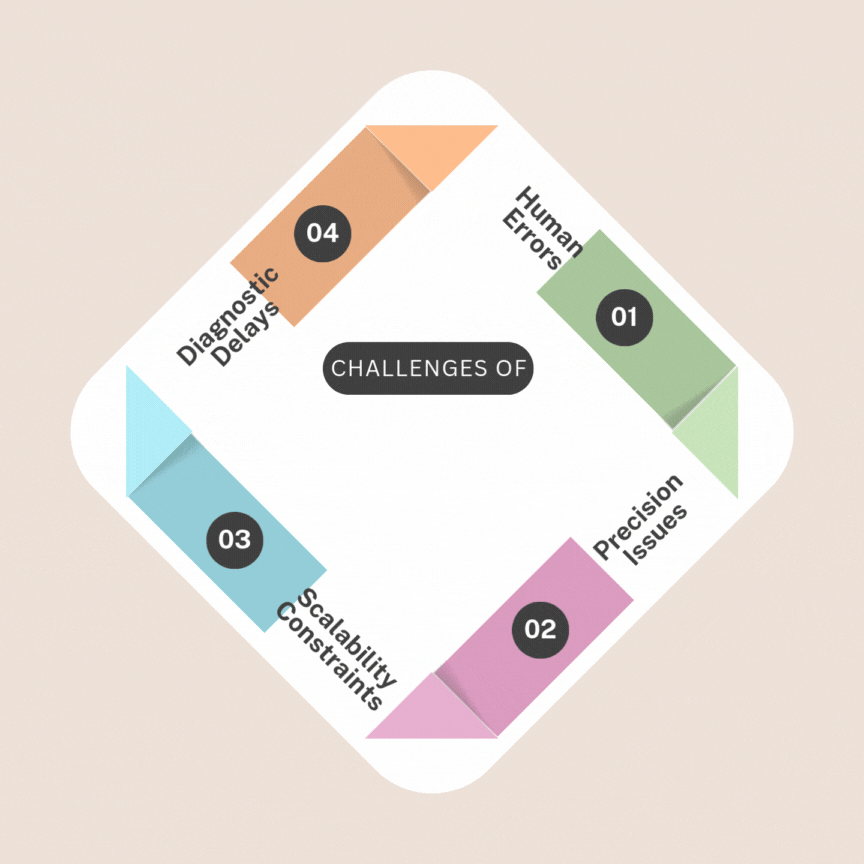Introduction to Medical Imaging AI Software
AI in medical imaging is among the most important technological breakthroughs in diagnosing and patient management. From plain films to sophisticated MRIs, these tools form the basis of healthcare diagnosis today.
The incorporation of medical imaging AI software is, therefore, a qualitative leap forward. This technology turns conventional imaging into practical diagnostic tools by improving patient treatment.
Importance of AI in Modern Healthcare
AI is fast becoming an essential aspect of modern healthcare diagnostics. Imaging technology in healthcare analyzes large volumes of data faster than ever, resulting in shorter diagnostic times.
These incidents have engendered unprecedented opportunities for medical AI software development. These AI innovations make it easier for healthcare providers to offer accurate, efficient, and accessible diagnoses.
Synopsis
Medical imaging AI software developers are transforming the healthcare industry by blending computer algorithms with regular image-based diagnosis. It claims to offer higher accuracy, less money, and better patient results and also puts quality diagnosing within each country’s reach.
Traditional Medical Imaging Techniques: Overview and Limitations
Healthcare professionals have used conventional imaging techniques for many years. These tools are some of the fundamental techniques of current diagnostic medicine but have recognized limitations in today’s high-speed clinical context.
Brief Overview of Conventional Imaging Methods
Conventional imaging methodology mainly includes X-rays, computer tomography scans, and magnetic resonance imaging. These traditional tools have been the mainstay in disease diagnosis for many years.
PET scans and ultrasound imaging systems obtain better evidence. They ensure that doctors appropriately use and prescribe various treatment regimes to patients.
Strengths of Traditional Imaging
Such approaches to imaging have produced accurate results for decades now. They are reliable strategies that various healthcare providers depend on to obtain accurate test outcomes.
These foundational tools function within the medical setting; they are interoperable with other standard-of-care protocols, give reproducible results, and are still valuable for today’s healthcare system.
Limitations and Challenges of Traditional Medical Imaging Techniques
Diagnostic Delays
A major drawback of the traditional manual approach to image analysis is that it is accompanied by a substantial increase in the time required for analysis. Martini et al. found that radiologists need to go through the results of each scan individually, thereby delaying critically important results.
Human Error
Imprecision is likely to occur even with senior radiologists, for instance, owing to tiredness or lack of vigilance. The medical images are complex, making the chances of misinterpretation higher.
Precision Issues
Most conventional analytical techniques do not identify certain minor irregularities. This means that some diseases can be overlooked or diagnosed at an early stage, which is essential for effective treatment.
Scalability Constraints
The ongoing and even increasing patient need for imaging services complicates available resources. Most facilities find it very hard to sustain efficient diagnostic services due to the unavailability of radiologists.
What is Medical Imaging AI Software?
Definition and Key Components
Diagnostic imaging and machine learning algorithms are combined to create medical imaging AI software. Neural networks and pattern recognition software are used to scan, interpret, and analyze medical images.
How AI Analyzes Imaging Data
Computer-aided diagnosis technologies in radiology software are programs designed to compute patterns and irregularities. These systems help analyze a large number of pictures within the shortest time; further, every picture becomes the material for learning.
AI in medical imaging means that diagnostic precision is constantly enhanced via a machine learning function. It compares new cases with huge databases of previous incidences.
Types of AI Used in Imaging
Deep Learning Algorithms
Machine learning, particularly deep learning in healthcare, enables AI to interpret figures in clinical images. These complex algorithms enhance the detection of abnormalities and other health problems.
Natural Language Processing (NLP)
NLP aids AI systems in reading and interpreting text, initially including radiology reports. This technology may be thought of as a link between image analysis and clinical records.
Explainable AI (XAI)
XAI offers automation and explains why the AI system has made certain decisions. It can explain and assure healthcare providers about AI-provided diagnostic suggestions.
AI in Action: Enhanced Medical Imaging Processes
Medical imaging AI software innovates traditional diagnostic methods by automating diagnosis, improving image quality, and providing faster analysis over previous methods for developing better best practices in delivering healthcare.
Automated Image Analysis
AI radiology tools simplify image analysis by alerting a physician or radiologist to abnormalities as the user zooms in. This technology is capable of processing a large number of images quickly, significantly decreasing the radiologist’s load while preserving the diagnostic capability.
Improving Image Quality and Clarity
Superior algorithms help increase the resolution of the image and deny noise in the scan. Diagnostic healthcare with AI provides more visibility and much more elaborate views, which are good for perceiving smaller variations.
Real-Time Diagnostics
Healthcare diagnostics with AI allows for the real-time interpretation of diagnostic imaging, such as MRI, CT scan, and X-ray. This becomes handy, especially during disasters, when the slightest delay in decision-making can cause many casualties.
AI vs. Traditional Imaging: Comparative Analysis
The incorporation of medical AI software development generally enhances acute diagnostics in terms of speed and accuracy over traditional conventional techniques.
Accuracy and Precision
According to the study, implementing artificial intelligence in medical imaging can detect various conditions with a high accuracy of up to 95%. This is even more efficient than conventional techniques, especially in diagnosing the first signs of diseases and minor alterations.
Diagnostic Speed
Whereas a professional takes hours, AI software for medical imaging usually produces results in minutes. This sharp cut in processing time enhances treatment considerations and patient care delivery.
Consistency and Reliability
AI systems never fade and provide constant levels of performance throughout the day and night; they do not fluctuate because of tiredness. Such reliability ensures that there is a continual quality of the analysis across all cases, regardless of time.
Scalability and Accessibility
AI healthcare solutions can decidedly enhance the ratio of scaling imaging services of healthcare units. Since this technology involves analyzing images from distant centers, diagnosis is also taken to the peripheral centers.
Real-World Applications of AI in Medical Imaging
Artificial intelligence applications integrated with radiology have shown remarkable efficiency in different fields of medicine and fundamentally changed the method of disease detection.
Cancer Detection
Diagnostic Imaging AI software is excellent at early cancer detection. It is designed to identify differences in mammograms, CT scans, and lung and skin images, among other things.
Neurological Disorders
maging technology in healthcare under this framework is an application of artificial intelligence that utilizes scan results to diagnose neurological disorders at an early stage. This technology assists in distinguishing faint signs that forecast Alzheimer’s or Parkinson’s disease.
Cardiovascular Diagnostics
In healthcare, deep learning allows for correct image interpretation of the cardiac part of the body. Healthcare diagnostics with AI correctly translate and interpret the results of echocardiograms and detect heart problems early.
Key Benefits of AI in Medical Imaging
Diagnostic imaging AI utilization results in turning healthcare processes into highly effective and customer-oriented industries.
Increased Diagnostic Accuracy
They show that AI for medical condition detection minimizes false positive and false negative rates to as low as 40%. This improves the diagnosis, and therefore, the appropriate treatment is provided.
Time and Cost Efficiency
When it comes to imaging software development in healthcare, operational costs are cut down by a third. AI automation helps to manage routes, thereby reducing cycle scanning and enhancing the usage of HR resources.
Enhanced Patient Care
Overcoming problems, AI healthcare solutions provide an opportunity to determine a patient’s state and diagnosis faster and more effectively. Treatment begins when the disease is still at an early stage, achieving better recovery rates.
Challenges and Ethical Considerations
This paper has presented these indications by recognizing several challenges and ethical issues regarding the incorporation of medical imaging AI software.
Data Privacy and Security Concerns
Intelligent systems require proper security measures in healthcare centers. The use and analysis of protected health information during AI means that robust protection measures have to be put in place during data processing and storage.
Bias in AI Algorithms
AI-based systems have to be trained with various data sets so that there will be no discrimination regarding output diagnosis. By constant monitoring and updating methods, such demographic bias can be significantly minimized in the design of medical AI software.
Regulatory and Legal Considerations
Automated diagnosis of disease requires artificial intelligence that is compliant with FDA rules. Organizations also require guidelines for the usage of AI and risk delegation.
Future Trends and Innovations in Medical Imaging AI
AI-powered imaging solutions advanced through AI remain to innovate the improvement of healthcare technology and employment of diagnosis.
Emerging Technologies and AI Advancements
One must mention 3D imaging analysis and its use in conjunction with AI during surgical planning as the advanced features. These innovations make diagnosis precise and noticeably accurate in defining treatment plans.
AI and Radiologist Collaboration
These are technology tools that work hand in hand with innovative human radiology. This relationship enhances work productivity but does not compromise the accuracy of the diagnosis.
AI in Telemedicine
Teleradiology is an application of AI software for analyzing diagnostic imaging that expands the categories of healthcare. Administrative-level diagnostic services are of high value to rural and hard-to-reach populations.
Guide for Healthcare Facilities: Implementing AI in Medical Imaging
AI software used for medical imaging is neither a small technical addition nor an ad hoc solution to an identified problem but rather an integral component that should be designed and introduced methodologically.
Evaluating Infrastructure Needs
Implementing AI in facilities requires robust infrastructure in the information technology department. This involves fast connectivity, safe archive storage, and compatible imaging modality.
Choosing an AI Software Provider
Choose integration partners who provide immense facilities for your healthcare software development solutions. Make sure they constantly update the users, remain resource-compliant with medical standards, and deliver constant assistance.
Training Healthcare Staff
Another is that AI implementation may be best accomplished with extensive staff training on these tools. Keeping the implementation constant and relevant through updates involved in education leads to optimal usage of diagnostic imaging AI.
Conclusion: Why AI is the Future of Medical Imaging
AI in medical imaging has brought drastic changes in diagnosis accuracy, time, and convenience. This technology has remained at the forefront of healthcare delivery across specialties.
Healthcare providers must incorporate AI-powered imaging solutions to sustain their market presence. The imperative for adoption stems from the realization of more accurate patient and operation care.
Final Thought
The use of artificial intelligence in the diagnosis of health problems will be realized in the future. Why is the use of medical imaging AI software and deep learning technologies not just an added extra in hospitals but is gradually becoming the new normal in diagnostic technologies?
FAQs
Medical imaging AI software applications employ artificial intelligence mechanisms to handle diagnostic image material. They aid doctors in identifying anomalies and diagnosing them with higher accuracy than using normal methodology.
AI can review images in the same way and can identify correlations even if they are sophisticated. It eliminates opportunities for human mistakes and offers results quickly and efficiently with reference to different data.
It is true that AI minimizes the diagnosis process and the number of scans to be repeated. It increases efficiency, reduces the rate of manual reviews, and aids in the best allocation of resources.
Professional radiologists will only deal with severe complications and be supervisors. Instead, they will be partnering with artificial intelligence to perform different tests and verify results that are often difficult to diagnose.
The current medical imaging artificial intelligence software or systems have strong security measures in place. Medical care centers always adhere to privacy acts and data security laws and policies.
AI is fast and also offers higher levels of precision in diagnosing compared to human beings. Faster, more efficient results, less often requiring a repeat of scans, and quicker treatment plans all add to a better experience for the patient.
Other trends that have hit subfields of radiography are 3D imaging analysis and remote diagnostic services. Automated AI healthcare solutions will remain on the rise by achieving higher precision and diversification.





